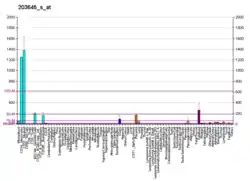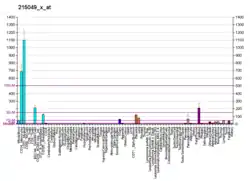CD163
CD163 — белок, клеточный рецептор. Продукт гена CD163[1]. Высокоаффинный рецептор-мусорщик (скавенджер-рецептор) комплексов гемоглобин-гаптоглобин[2], а в отсутствие гаптоглобина (с более низкой аффинностью) — гемоглобина[3]. Экспрессирован на клетках моноцитарно-макрофагального ряда[4]. CD163 действует как иммунный сенсор на грамположительные и грамотрицательные бактерии[5][6]. Впервые описан в 1987 году[7].
| CD163 | |||||||||||||
|---|---|---|---|---|---|---|---|---|---|---|---|---|---|
| Идентификаторы | |||||||||||||
| Символы | CD163, M130, MM130, SCARI1, CD163 molecule | ||||||||||||
| Внешние IDs | OMIM: 605545 MGI: 2135946 HomoloGene: 128811 GeneCards: 9332 | ||||||||||||
| |||||||||||||
| Профиль экспрессии РНК | |||||||||||||
  | |||||||||||||
| Больше информации | |||||||||||||
| Ортологи | |||||||||||||
| Виды | Человек | Мышь | |||||||||||
| Entrez | |||||||||||||
| Ensembl | |||||||||||||
| UniProt | |||||||||||||
| RefSeq (мРНК) | |||||||||||||
| RefSeq (белок) | |||||||||||||
| Локус (UCSC) | Chr 12: 7.47 – 7.5 Mb | Chr 6: 124.28 – 124.31 Mb | |||||||||||
| Поиск PubMed | |||||||||||||
| Править (человек) | Править (мышь) | ||||||||||||
Структура
Белок CD163 состоит из 1048 аминокислот, молекулярная масса — 130 кДа. Входит в семейство обогащённых цистеином рецепторов-«мусорщиков» SRCR.
Функция
Белок CD163 — рецептор острой фазы, который участвует в очищении организма от комплексов гемоглобин-гаптоглобин и их эндоцитоз макрофагами и, таким образом, играет роль в защите тканей организма от повреждения свободным гемоглобином в результате окислительного повреждения, к которому последний способен привести. Участвует в захвате железа и его повторном использовании посредством эндоцитоза комплексов гемоглобин-гаптоглобин и последующего разложения гема. Связывание комплекса гемоглобин-гаптоглобин — кальций- и pH-зависимый процесс. CD163 запускает внутриклеточные сигналы, включающие тирозинкиназно-зависимую мобилизацию кальция, синтез инозитолтрифосфата и секрецию IL6 и CSF1.
После отщепления от мембраны свободная (растворимая) форма может играть противовоспалительную роль и служить диагностическим параметром активации макрофагов при воспалительных заболеваниях.
Клиническое значение
Растворимая форма рецептора присутствует в плазме и спинномозговой жидкости[8] и, как правило, обозначается sCD163. Образуется в результате отщепления эктодомена от мембраны и может представлять собой форму модулирования функции CD163[9] Отщепление sCD163 происходит в результате ферментативной активности протеазы ADAM17[10]. Повышенное содержание sCD163 обнаружено при широком спектре воспалительных заболеваний, включая цирроз печени, диабет, синдром активации макрофагов, болезнь Гоше, сепсис, ВИЧ-инфекция, ревматоидный артрит и лимфогранулематоз[11][12]. Кроме этого, sCD163 увеличивается в спинномозговой жидкости после субарахноидального кровоизлияния[8]. Экспрессия CD163 была также обнаружена на нейронах центральной нервной системы, однако его функция на этих клетках неизвестна[13][14][15].
Взаимодействия
CD163 взаимодействует с CSNK2B[16].
Примечания
- Entrez Gene: CD163 CD163 molecule.
- Kristiansen M, Graversen JH, Jacobsen C, Sonne O, Hoffman HJ, Law SK, Moestrup SK (January 2001). “Identification of the haemoglobin scavenger receptor”. Nature []. 409 (6817): 198—201. DOI:10.1038/35051594. PMID 11196644. Неизвестный параметр
|s2cid=(справка) - Schaer DJ, Schaer CA, Buehler PW, Boykins RA, Schoedon G, Alayash AI, Schaffner A (January 2006). “CD163 is the macrophage scavenger receptor for native and chemically modified hemoglobins in the absence of haptoglobin”. Blood. 107 (1): 373—80. DOI:10.1182/blood-2005-03-1014. PMID 16189277.
- Lau SK, Chu PG, Weiss LM (November 2004). “CD163: a specific marker of macrophages in paraffin-embedded tissue samples”. American Journal of Clinical Pathology. 122 (5): 794—801. DOI:10.1309/QHD6YFN81KQXUUH6. PMID 15491976.
- Fabriek BO, van Bruggen R, Deng DM, Ligtenberg AJ, Nazmi K, Schornagel K, Vloet RP, Dijkstra CD, van den Berg TK (January 2009). “The macrophage scavenger receptor CD163 functions as an innate immune sensor for bacteria” (PDF). Blood. 113 (4): 887—92. DOI:10.1182/blood-2008-07-167064. PMID 18849484.
- Van Gorp H, Delputte PL, Nauwynck HJ (April 2010). “Scavenger receptor CD163, a Jack-of-all-trades and potential target for cell-directed therapy”. Molecular Immunology. 47 (7—8): 1650—60. DOI:10.1016/j.molimm.2010.02.008. PMID 20299103.
- Onofre G, Kolácková M, Jankovicová K, Krejsek J (2009). “Scavenger receptor CD163 and its biological functions”. Acta Medica. 52 (2): 57—61. PMID 19777868.
- Galea J, Cruickshank G, Teeling JL, Boche D, Garland P, Perry VH, Galea I (June 2012). “The intrathecal CD163-haptoglobin-hemoglobin scavenging system in subarachnoid hemorrhage”. Journal of Neurochemistry. 121 (5): 785—92. DOI:10.1111/j.1471-4159.2012.07716.x. PMC 3412209. PMID 22380637.
- Droste A, Sorg C, Högger P (March 1999). “Shedding of CD163, a novel regulatory mechanism for a member of the scavenger receptor cysteine-rich family”. Biochemical and Biophysical Research Communications. 256 (1): 110—3. DOI:10.1006/bbrc.1999.0294. PMID 10066432.
- Etzerodt A, Maniecki MB, Møller K, Møller HJ, Moestrup SK (December 2010). “Tumor necrosis factor α-converting enzyme (TACE/ADAM17) mediates ectodomain shedding of the scavenger receptor CD163”. Journal of Leukocyte Biology. 88 (6): 1201—5. DOI:10.1189/jlb.0410235. PMID 20807704. Неизвестный параметр
|s2cid=(справка) - Jones K, Vari F, Keane C, Crooks P, Nourse JP, Seymour LA, Gottlieb D, Ritchie D, Gill D, Gandhi MK (February 2013). “Serum CD163 and TARC as disease response biomarkers in classical Hodgkin lymphoma”. Clinical Cancer Research. 19 (3): 731—42. DOI:10.1158/1078-0432.CCR-12-2693. PMID 23224400.
- Møller HJ (February 2012). “Soluble CD163”. Scandinavian Journal of Clinical and Laboratory Investigation. 72 (1): 1—13. DOI:10.3109/00365513.2011.626868. PMID 22060747. Неизвестный параметр
|s2cid=(справка) - Garton TP, He Y, Garton HJ, Keep RF, Xi G, Strahle JM (15 March 2016). “Hemoglobin-induced neuronal degeneration in the hippocampnus after neonatal intraventricular hemorrhage”. Brain Research. 1635: 86—94. DOI:10.1016/j.brainres.2015.12.060. PMC 4801173. PMID 26772987.
- Garton T, Keep RF, Hua Y, Xi G (April 6, 2017). “CD163, a Hemoglobin/Haptoglobin Scavenger Receptor, After Intracerebral Hemorrhage: Functions in Microglia/Macrophages Versus Neurons”. Translational Stroke Research. 8 (6): 612—616. DOI:10.1007/s12975-017-0535-5. PMID 28386733.
- Liu R, Cao S, Hua Y, Keep RF, Huang Y, Xi G (May 1, 2017). “CD163 Expression in Neurons After Experimental Intracerebral Hemorrhage”. Stroke. 48 (5): 1369—1375. DOI:10.1161/STROKEAHA.117.016850. PMC 5404936. PMID 28360115.
- Ritter M, Buechler C, Kapinsky M, Schmitz G (April 2001). “Interaction of CD163 with the regulatory subunit of casein kinase II (CKII) and dependence of CD163 signaling on CKII and protein kinase C”. European Journal of Immunology. 31 (4): 999—1009. DOI:10.1002/1521-4141(200104)31:4<999::AID-IMMU999>3.0.CO;2-R. PMID 11298324.
Литература
- Ren H, Han R, Chen X, Liu X, Wan J, Wang L, Yang X, Wang J (May 2020). “Potential therapeutic targets for intracerebral hemorrhage-associated inflammation: An update”. J Cereb Blood Flow Metab. 40 (9): 1752—1768. DOI:10.1177/0271678X20923551. PMC 7446569. PMID 32423330.
- Graversen JH, Madsen M, Moestrup SK (April 2002). “CD163: a signal receptor scavenging haptoglobin-hemoglobin complexes from plasma”. The International Journal of Biochemistry & Cell Biology. 34 (4): 309—14. DOI:10.1016/S1357-2725(01)00144-3. PMID 11854028.
- Madsen M, Graversen JH, Moestrup SK (2002). “Haptoglobin and CD163: captor and receptor gating hemoglobin to macrophage lysosomes”. Redox Report. 6 (6): 386—8. DOI:10.1179/135100001101536490. PMID 11865982.
- Moestrup SK, Møller HJ (2005). “CD163: a regulated hemoglobin scavenger receptor with a role in the anti-inflammatory response”. Annals of Medicine. 36 (5): 347—54. DOI:10.1080/07853890410033171. PMID 15478309. Неизвестный параметр
|s2cid=(справка) - Maruyama K, Sugano S (January 1994). “Oligo-capping: a simple method to replace the cap structure of eukaryotic mRNAs with oligoribonucleotides”. Gene. 138 (1—2): 171—4. DOI:10.1016/0378-1119(94)90802-8. PMID 8125298.
- Law SK, Micklem KJ, Shaw JM, Zhang XP, Dong Y, Willis AC, Mason DY (September 1993). “A new macrophage differentiation antigen which is a member of the scavenger receptor superfamily”. European Journal of Immunology. 23 (9): 2320—5. DOI:10.1002/eji.1830230940. PMID 8370408.
- Suzuki Y, Yoshitomo-Nakagawa K, Maruyama K, Suyama A, Sugano S (October 1997). “Construction and characterization of a full length-enriched and a 5'-end-enriched cDNA library”. Gene. 200 (1—2): 149—56. DOI:10.1016/S0378-1119(97)00411-3. PMID 9373149.
- Droste A, Sorg C, Högger P (March 1999). “Shedding of CD163, a novel regulatory mechanism for a member of the scavenger receptor cysteine-rich family”. Biochemical and Biophysical Research Communications. 256 (1): 110—3. DOI:10.1006/bbrc.1999.0294. PMID 10066432.
- Ritter M, Buechler C, Langmann T, Schmitz G (July 1999). “Genomic organization and chromosomal localization of the human CD163 (M130) gene: a member of the scavenger receptor cysteine-rich superfamily”. Biochemical and Biophysical Research Communications. 260 (2): 466—74. DOI:10.1006/bbrc.1999.0866. PMID 10403791.
- Van den Heuvel MM, Tensen CP, van As JH, Van den Berg TK, Fluitsma DM, Dijkstra CD, Döpp EA, Droste A, Van Gaalen FA, Sorg C, Högger P, Beelen RH (November 1999). “Regulation of CD 163 on human macrophages: cross-linking of CD163 induces signaling and activation”. Journal of Leukocyte Biology. 66 (5): 858—66. DOI:10.1002/jlb.66.5.858. PMID 10577520. Неизвестный параметр
|s2cid=(справка) - Buechler C, Ritter M, Orsó E, Langmann T, Klucken J, Schmitz G (January 2000). “Regulation of scavenger receptor CD163 expression in human monocytes and macrophages by pro- and antiinflammatory stimuli”. Journal of Leukocyte Biology. 67 (1): 97—103. DOI:10.1002/jlb.67.1.97. PMID 10648003. Неизвестный параметр
|s2cid=(справка) - Stover CM, Schleypen J, Grønlund J, Speicher MR, Schwaeble WJ, Holmskov U (2001). “Assignment of CD163B, the gene encoding M160, a novel scavenger receptor, to human chromosome 12p13.3 by in situ hybridization and somatic cell hybrid analysis”. Cytogenetics and Cell Genetics. 90 (3—4): 246—7. DOI:10.1159/000056781. PMID 11124526. Неизвестный параметр
|s2cid=(справка) - Kristiansen M, Graversen JH, Jacobsen C, Sonne O, Hoffman HJ, Law SK, Moestrup SK (January 2001). “Identification of the haemoglobin scavenger receptor”. Nature. 409 (6817): 198—201. DOI:10.1038/35051594. PMID 11196644. Неизвестный параметр
|s2cid=(справка) - Ritter M, Buechler C, Kapinsky M, Schmitz G (April 2001). “Interaction of CD163 with the regulatory subunit of casein kinase II (CKII) and dependence of CD163 signaling on CKII and protein kinase C”. European Journal of Immunology. 31 (4): 999—1009. DOI:10.1002/1521-4141(200104)31:4<999::AID-IMMU999>3.0.CO;2-R. PMID 11298324.
- Sulahian TH, Hintz KA, Wardwell K, Guyre PM (June 2001). “Development of an ELISA to measure soluble CD163 in biological fluids”. Journal of Immunological Methods. 252 (1—2): 25—31. DOI:10.1016/S0022-1759(01)00328-3. PMID 11334962.
- Högger P, Sorg C (November 2001). “Soluble CD163 inhibits phorbol ester-induced lymphocyte proliferation”. Biochemical and Biophysical Research Communications. 288 (4): 841—3. DOI:10.1006/bbrc.2001.5845. PMID 11688984.
- Fonseca JE, Edwards JC, Blades S, Goulding NJ (May 2002). “Macrophage subpopulations in rheumatoid synovium: reduced CD163 expression in CD4+ T lymphocyte-rich microenvironments”. Arthritis and Rheumatism. 46 (5): 1210—6. DOI:10.1002/art.10207. PMID 12115225.
- Frings W, Dreier J, Sorg C (August 2002). “Only the soluble form of the scavenger receptor CD163 acts inhibitory on phorbol ester-activated T-lymphocytes, whereas membrane-bound protein has no effect”. FEBS Letters. 526 (1—3): 93—6. DOI:10.1016/S0014-5793(02)03142-3. PMID 12208511. Неизвестный параметр
|s2cid=(справка) - Matsushita N, Kashiwagi M, Wait R, Nagayoshi R, Nakamura M, Matsuda T, Hogger P, Guyre PM, Nagase H, Matsuyama T (October 2002). “Elevated levels of soluble CD163 in sera and fluids from rheumatoid arthritis patients and inhibition of the shedding of CD163 by TIMP-3”. Clinical and Experimental Immunology. 130 (1): 156—61. DOI:10.1046/j.1365-2249.2002.01963.x. PMC 1906487. PMID 12296867.
